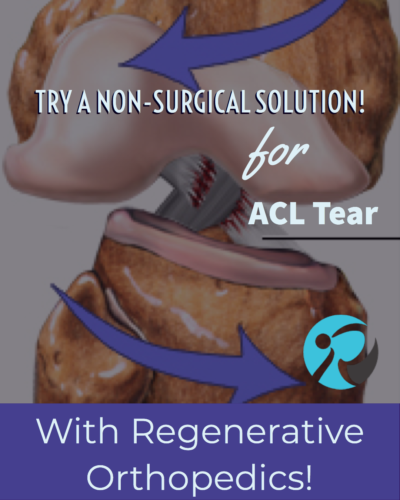
Non-Surgical ACL Tear Repair
ACL tears are a pretty common injury! With ACL tears and other ligament injuries, the knee becomes unbalanced. And the knee will become unstable when these various structures of the knee are injured, torn, or degenerated.
There is a very complex yet intricate interplay between the different structures of the knee, such as the tendons, ligaments, meniscus, and muscles. And when any of these are injured, the whole knee becomes out of sorts.
Ligament injuries are one of the common disruptions to this balance. The four major ligaments of the knee include the anterior cruciate ligament (ACL), the posterior cruciate ligament (PCL), the medial collateral ligament (MCL), and the lateral collateral ligament (LCL).
Injuries that damage the meniscus and cartilage can also injure these ligaments. And once the injury to ligaments occurs, whether by trauma or by wear and tear, the other structures will be affected. Then, over time, the injury will lead to degeneration of the knee joint and arthritis. The ligaments become loose with injury. And similar to a stretched-out rubber band, they lose their tautness. When injury to one ligament occurs, as in the case of an ACL tear, it is not uncommon that some of the other ligaments are injured as well.
Surgery is often resorted to for ligament injuries. However, surgical cutting and removal of important knee structures actually add to the instability. Why? Because the loss of these stabilizing structures boosts the degenerative process.
But you do have a non-surgical option. Regenerative Orthopedics is a non-surgical option capable of repairing torn and injured ligaments. The treatment strengthens the loose ligaments and restores the normal motion back to the knee. And it resolves the pain too!
Remember, it is very likely that more than just one ligament or joint structure is affected. Therefore, all of the affected structures need to be treated. Otherwise, the knee will remain unstable. And then the instability>degeneration>pain cycle will continue. Comprehensive treatment of the knee and all of the affected soft tissue structures will ensure that the knee will be strong and stable.
Surgery is necessary when the ligament is completely torn. But the majority of cases are partial tears. And Regenerative Orthopedics is effective at repairing these ligaments, and stabilizing the knee once the ligaments are repaired.
The anterior and posterior cruciate ligaments help stabilize the knee. They also prevent excessive forward and backward movement. When these ligaments are injured, the knee may feel like it is loose. That’s because these ligaments are powerhouses at keeping the knee stable. Pain with injury to these ligaments is often felt at the back of the knee.
Even after the ACL ligament is repaired surgically, knee instability can occur. And there may be a feeling of looseness or a sensation that the knee can still give way. ACL reconstructive surgery works for many patients, but others experience continued symptoms.
Oftentimes, those who are athletes want to get their knee repaired as quickly as possible. And they often resort to surgery thinking it will be a quick fix. But research suggests there are high levels of failure rates to restore stability in ACL repairs. And many of the patients in these studies are unable to return to their previous level of the sport.
Surgical ACL reconstruction also accelerates the degeneration of the knee. Researchers have found that those who have had ACL reconstruction have an advanced risk for arthritis, as well as a higher long-term risk of requiring a knee replacement. But how many people does this really affect? Unfortunately, it’s not just a few. Researchers show that the failure rate is 10-25%. The problems of knee instability following an ACL tear reconstruction surgery can be severe enough to require repeat surgery.
Fortunately, Regenerative Orthopedics is a non-surgical alternative to ACL surgery or even repeat surgery. In our opinion, it is a better solution to repair a stretched-out, loose, torn, or injured ligament. This treatment approach strengthens and heals the injured ligament in a non-surgical fashion, restoring the stability of the knee.
Avoid the unsatisfactory outcome of incomplete healing and repair, and seek a consult with a clinician familiar with Regenerative Orthopedics. These regenerative options include Stem Cell Therapy, PRP, and Prolotherapy. And all of them have the goal of restoring normal ligament function and getting you back quickly to performing the sport and activity you love.
We see patients in our clinic who have already had ACL tear surgery too. These patients come to see us because they continue to have symptoms that are keeping them from doing the sports and activities they want to do. They thought for sure once they had the ACL surgery they would be back to doing what they were doing before the surgery. But they can’t. Other patients come because they are suffering from post-surgical complications and are looking for answers and a solution to their ongoing pain.
Get your life back with Regenerative Orthopedics. Contact us soon!